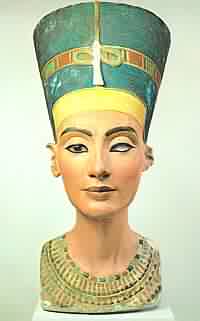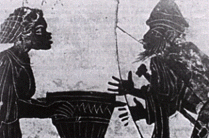
MARCH OF THE TITANS - A HISTORY OF THE WHITE RACE
CHAPTER 9 : ALPHA AND OMEGA -
THE RISE AND FALL OF CIVILIZATIONS
What is meant by a "civilization"? There are probably as many definitions as sources one would care to consult - many of them are subjective in nature, classifying nations by technological advances or other narrow factors.
For the purposes of this book, civilization will be taken to mean the entire ambit of social/cultural manifestations which are characteristic to any particular nation or racial group. In this way the accusation of subjectivity can be avoided. Civilization, in the broadest sense of the word, includes all social manifestations, from social interactions to language, art forms, science, technology, customs and culture.
It is therefore possible to talk of a Japanese civilization, an American Indian (Amerind) civilization, a Polynesian civilization, an Australian Aboriginal civilization, a Black civilization and a White civilization, without being subjective about any of them.
THE QUESTION POSED BY RISE AND FALLS
When reviewing the historical development of all nations, quite often mention is made of a "rise and fall" of particular civilizations. This poses a major question: Why is that Japan, Sweden, England and Germany (as examples), all nations with limited natural resources, can have progressive active cultures after more than 2,000 years - and then why did such mighty nations as Rome, Greece, Persia, India, Portugal and even Spain produce active vibrant civilizations for a few centuries, and then fall, never to rise again?
Politically correct historians blame the rise and fall of the great nations of the past on politics, economics, morals, lawlessness, debt, environment and a host of other superficial reasons.
However, Japan, England, Sweden and Germany have gone through these crises of these nature scores of times, without those countries falling into decay. It is obvious that there must be some other factor at work - something much more fundamental than just a dip in politics, morals, lawlessness or any of the other hundreds of reasons that historians have attempted to dream up.
EACH SOCIETY UNIQUE TO EACH PEOPLE
Herein lies the key to understanding the rise and fall of all civilizations, no matter where they are or who they are. In any given territory, the people making up the society in that territory create a culture which is unique to themselves. A society or civilization is only a reflection of the population of that particular territory. For example: The Chinese civilization is a product of the Chinese people, and is a reflection of the makeup of the population living in China. The Chinese civilization is unique to the Chinese people, they made it and it reflects their values and norms.
As the Chinese people made the Chinese civilization, it logically follows that the Chinese culture would disappear if the Chinese people were to disappear.
Presently the overwhelming majority of Chinese people live in China, creating the Chinese civilization in that land. If however Australian Aborigines had to immigrate to China in their millions, and the Chinese population had to dramatically reduce in numbers, then in a few years the character of Chinese civilization would change - to that reflecting the new inhabitants of that territory.
In other words, the society or civilization of that territory would then reflect the fact that the majority of inhabitants were now Aborigines rather than Chinese people. If China had to fill up with Aborigines, this would mean the end of Chinese civilization. Aborigines would create a new civilization which would reflect themselves, and not that of the Chinese people.
That this should happen is actually perfectly logical. It is has nothing to do with which culture is more advanced, or any notions of superiority or inferiority - merely a reflection of the fact that a civilization is a product of the nature of the people making up the population in the territory.
A THEORETICAL EXAMPLE
To go back to the Chinese example: If all Chinese people on earth had to disappear tomorrow, then fairly obviously, Chinese civilization and culture would disappear with them. It is exactly this startlingly obvious principle which determines the creation and dissolution of civilizations - once the people who create a certain society or civilization disappear, then that society or civilization will disappear with them.
If the vanished population is replaced by different peoples, then a new society or culture is created, which reflects the culture and civilization of the new inhabitants of that region.
A PRACTICAL EXAMPLE
There are numerous examples of this process at work. One which will be familiar to all is the shift which occurred in North America. On that continent, the Amerind (American Indian) people lived for thousands of years, creating a civilization which dominated that continent. In other words, the civilization and culture which dominated North America reflected the fact that the Amerind people lived and formed the majority population there.
After 1500 AD, however, that continent filled up with White immigrants from Europe. These White immigrants displaced the Amerinds by squeezing them out of possession of North America.
The great shift in North American civilization then occurred. Whereas the Amerind culture had dominated for thousands of years, in a few hundred years the dominant civilization on that continent had become White European. This shift reflected the fact that the majority of inhabitants of North America had become White Europeans - and the Amerind civilization, for all practical purposes, disappeared. The Amerind civilization in North America "fell" because the population of North America changed.
RACIAL SHIFT PARAMOUNT
This effect - the displacement of peoples and the subsequent disappearance of their civilization - has direct implications in racial terms. So the rise and fall of any particular civilization can therefore be traced, not by the economics, politics, morals etc. of a particular civilization, but rather by the actual racial presence of the people themselves. If the society which has produced a particular civilization stays intact as a racially homogeneous unit, then that civilization remains active.
If however the society within any particular given area changes its racial makeup - through invasion, immigration or any decline in numbers - then the civilization which that society has produced will disappear with them, to be replaced by a new civilization reflecting the new inhabitants of that territory.
DISAPPEARANCE OF WHITES LED TO THE DISAPPEARANCE OF THEIR CIVILIZATIONS
Originally created by Proto-Nordics, Alpines and Mediterraneans, and then influenced by waves of Indo-European invaders, the White civilizations in the ancient world, the Near and Middle East all flourished, producing the wonders of the ancient world.
These regions were either invaded or otherwise occupied (through the use of laborers or by immigration, or in rare cases, by conquest) by Nonwhite peoples - Semitic speaking peoples, and in many cases Black peoples.
What happened was that the original White peoples who made up those civilizations vanished, were killed or were absorbed into other races, and with their disappearance, so their civilizations "fell" in exactly the same way that the Amerind civilization in North America "fell."
500 BC - FIRST TURNING POINT IN WHITE HISTORY
It is around the year 500 BC, that the first great turning point in White history was reached. This was the decline of the first great White civilizations in the Middle and Near East and their replacement by nations and peoples of a substantially different racial makeup.
Up until this time the development of White race's territorial expansion was such that they were a majority in Europe and western Russia and formed a significant component of the population of the Middle East, extending their rule into the Indus river valley in Northern India.
INDIA - ORIGIN OF THE CASTE SYSTEM
In India, for example, the Indo-Aryan population was diminished by four factors:
In India, the invading Indo-Aryans established a strict segregation system to keep themselves separate from the local dark skinned native population. This system was so strict that it has lasted to this day and has become known as the caste system.
However, even the strictest segregation (and Aryan laws prescribing punishments such as death for miscegenation) did not prevent the majority population from eventually swallowing up the ruling Aryans till the situation has been reached today when only a few very high caste Brahmin Indians could still pass as Europeans.
Exactly the same thing happened in central Asia, Egypt, Sumeria, and to a less marked degree, in modern Turkey. Slowly but surely, as these civilizations relied more and more on others to do their work for them, or were physically conquered by other races, their population makeup became darker and darker.
EGYPT - DECLINE A RESULT OF MISCEGENATION WITH SLAVES
The original White Egyptians, for their part, had from the time of the Old Kingdom, been using Nubian - or Black - and Semitic (or Arabic) labor to help with the work on many of their building projects or as general slaves.
At various stages the Pharaohs also employed Nubian mercenaries, and ultimately Nubia and Sudan were physically occupied and incorporated into the Egyptian empire. Although the buildings of ancient Egypt are very impressive - many having survived through to present times, technologically speaking, their construction was dependent on the Egyptian ability to organize an unprecedented mass of human labor.
Under the direction of a scribe and architect, thousands of slaves and regiments of soldiers labored for decades to create the great buildings, using only levers, sleds and massive ramps of earth. It is impossible to think that such massive use of slave and foreign labor would not have left some mark on the population of the land. Interbreeding took place, and this combined with the natural growth and reproduction patterns of the slaves and laborers meant that in a relatively short time they compromised a significant section of the population.
Despite several attempts to prevent large numbers of Nubians from settling in Egypt - one of the first recorded racial separation laws is inscribed on a stone on the banks of the southern Nile, forbidding Nubians from proceeding north of that point - the use of Nubians for labor of all sorts gradually led to the establishment of a resident Nonwhite population. This population gradually grew in numbers, through natural reproduction and continued immigration.
The region also was occupied for 200 years by the Semitic Hyksos, who also intermarried with the local population, and this was followed up with other Semitic/Arabic immigration, fueled by the long existing Black settlement on the southern most reaches of the Nile river itself.
Once again the factors which led to the extinction of the Aryans in India came to work in Egypt - a resident Nonwhite population to do the labor - a natural increase in Nonwhite numbers - physical integration - and a decline in the original White birth rate - all these compounded to produce an eventual Egyptian population makeup of today that is very different to the men and women who had founded Egypt and who had built the pyramids.
As the population make up shifted, so the cultural manifestations, or civilization of that region, changed - to the point where the present day population of the Middle East is not by any stretch of the imagination classifiable as White.
This explains why the present inhabitants of Egypt are not the same people who built the pyramids. The Egyptians of today are a completely different people, racially and culturally, living amongst the ruins of another race's civilization.

Evidence of the use of Black slaves in Egyptian society. This Egyptian kohl (eye paint) pot is carried by a young Black Nubian slave girl - no doubt the pot's owner would have been served by just such a female slave. The pot dates from the 18th Dynasty (1567 - 1320 BC).



1350 BC...............................100 AD ..............................1970 AD
Egypt: same country, different people.
On the left, the White Female Pharaoh, Queen Nefertiti, circa 1,350 BC; in the center, the effects of racial mixing are clearly to be seen on the face of this coffin portrait of a Roman lady in Hawara, Egypt, 100 AD; and on the right, the mixed race Egyptian, Anwar Sadat, president of Egypt in the 20th century. Nefertiti ruled over an advanced civilization; Sadat ruled over a Third World country. The reason for the difference in cultures between Nefertiti's Egypt and Sadat's Egypt was that the Egyptian people themselves had changed.
MIDDLE EAST
The decline and eventual extinction of the White populations in the Middle East mark the end of the original civilizations in these regions. In all the Middle Eastern countries the Semitic, Arabic, and Black populations also began to grow as they were increasingly used as labor by the ruling Whites - or in the case of Sumer, where the White rulers were physically displaced by military conquest at the hands of Semitic invaders.
This process continued until virtually all remains of the original Indo-Europeans in the greater region were assimilated into the darker populations, with only the occasional appearance of light colored hair or eyes amongst today's Iraqis, Iranians, Syrians, and Palestinians, left to serve as reminders of the original rulers of these territories.
LESSON - ROLE OF RACIALLY FOREIGN LABOR IN THE DECLINE OF A CIVILIZATION
The lesson is clear: As long as a race - any race, be it White, Black, or Mongolian - maintains its territorial integrity and does not start to rely on others not of its own or similar race to provide its labor, that civilization will stand intact. Once it starts to allow large numbers of other races into its midst (to do the labor and then to integrate with the newcomers) then that civilization will change - or in many cases, vanish completely. This fact applies equally to all civilizations, no matter who their original creators are, anywhere in the world.
A civilization - any civilization, be it White, Black, Asian or Aboriginal - stands or falls by the homogeneity of its population, and nothing else. As soon as a society loses its homogeneity, the nature of that society changes.
In reality, this is a perfectly logical principle and is not even an opinion, but a simple statement of fact and of the obvious.
GREECE AND ROME
The early White civilizations in Greece and Rome also fell to this process. The last great Grecian leader, Pericles, actually enacted a law in the year 451 BC limiting citizenship of the state by racial descent.
However, some 400 years later this law was changed as the population shifts had become more and more evident. Today there are significant genetic differences between many inhabitants of Greece and the original inhabitants of that country, although this change is not as complete as in a place such as Egypt.

Above: Classical Greece lasted from 800 BC to 400 BC. Its fall can be traced to a shift in population make-up which occurred there from 500 BC onwards, when the first Black slaves and Black freemen began to enter that society. Within 100 years of Blacks becoming commonplace in ancient Classical White Greece, that civilization collapsed. Two original depictions, both dating from circa 500 BC, show the trend clearly: Left, a vase depicting a Negroid female, and right, a double headed vase showing a Black and a White face, reflecting the two elements in late Grecian society (see chapter 10).
Certain Roman leaders also tried to turn back the racial clock, but ultimately these efforts were also to be in vain - the sheer vastness of the Roman Empire meant that all sorts of races were included in its borders, and this heady brew ultimately led to the dissolution of the original Roman population, as described in detail in a later chapter of this book.
Those who occupy a territory, determine the nature of the society in that territory. This is an immutable law of nature which cannot be escaped. This is very principle upon which history is founded: History is a function of race.
or back to
or
All material (c) copyright Ostara Publications, 1999.
Re-use for commercial purposes strictly forbidden.